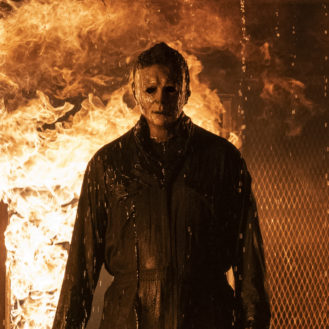By: Trevor Chartrand
The meandering narrative of Lady Bird, though at times unfocused and opened-ended, is both heartwarming and humorous as it examines the life of a struggling teen overwhelmed by dysfunction and her perceived notion of persecution at every turn. An offbeat coming-of-age comedy, Lady Bird wonderfully depicts the innocence of youth in search of love, purpose, and acceptance in a confusing and changing world.
Naïve and entitled, the attention-seeking traits of Christine “Lady Bird” McPherson (Saoirse Ronan) may make her an irrational, frustrating character, but she’s someone we’ve all likely been at some point in our lives. To Lady Bird, her life in Sacremento is faced with oppression and slander. Her pessimistic outlook paints her hometown as a city divided by class, where her impoverished family is too poor and uncaring to help her achieve her hopes and dreams. Christine fails to see the reality that she’s better off than most, with a family that loves and challenges her, not realizing most of her problems are of her own design.
At the heart of the film is the challenging give-and-take relationship between Lady Bird and her mother Marion, played brilliantly by Laurie Metcalf. Christine’s mother is a true hard-ass, a realist who’s not afraid to confront her daughter and tell her how things really are. She refuses to soften the truth while trying to straighten her daughter out. But to Lady Bird, who is equally stubborn and outspoken, Marion is the last person she wants to take advice from – fearing she may become the failure she perceives her mother to be.
In school, Lady Bird struggles to find her place, often following the crowd and feigning interest in whatever her latest crush likes most. She joins a drama club first to help get into college, but later to impress a boy. She recreates herself constantly depending on what social situation she’s in. Her high school social struggles are reminiscent of 2004’s Mean Girls, only they’re presented in a more grounded and realistic way.
Writer/Director Greta Gerwig’s greatest achievement with Lady Bird is her clear love for her characters. She successfully creates authentic teenagers, primarily by highlighting the way young minds place significance and meaning in things that don’t necessarily matter long-term, with high school students latching onto relationships and ideas that are nowhere near as meaningful as these kids want them to be. Conversely, the adults in the film are jaded and cynical realists, having lived past a time when every experience is exciting and new. The film effectively, even cynically, showcases the hopes and dreams of youth versus the unhappy reality of where adulthood may take these younger characters.
The subplot-heavy film, unfortunately, leaves a lot of questions unanswered, too frequently introducing the struggles of ancillary characters without resolution. There’s the drama teacher who leaves the school due to a vague mental illness, as well as a caring catholic school nun who offers guidance to Lady Bird. The self-centred Christine character may be too focused on herself to follow up with these people but, as an audience member, these unresolved subplots are disappointing, leaving the film feeling incomplete or unfinished.
The most underrated character, Lady Bird’s best friend Julie, is portrayed with a hilarious innocence and optimism by Beanie Feldstein. This is definitely someone we don’t see enough of, given her quirky ambition and her ability to steal each scene she’s in. Her positive, hopeful performance is infectious. Unfortunately, she is significantly underutilised and underdeveloped, left behind when Christine seeks fulfillment elsewhere. Like so many characters in this film, Julie’s story doesn’t ever seem completely resolved.
Overall, the unfocused plot of Lady Bird is detrimental to the finished film, but it’s also a testament to a script that focuses on compelling characters and effective world-building. While the story leaves something to be desired, it’s only because these people feel so real that viewers will want to spend more time with them. Some of the secondary characters are just as interesting as the protagonist, and as a result this is a film that leaves you wanting more, but for the right reasons.
**********
Do You Tweet? Follow These Tweeple:
Trevor Chartrand: @OhHaiTrebor





Leave a comment